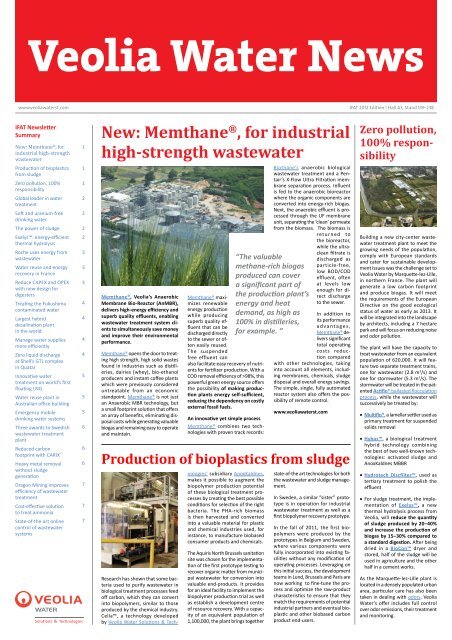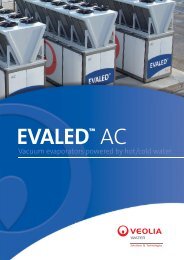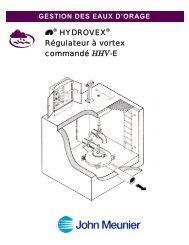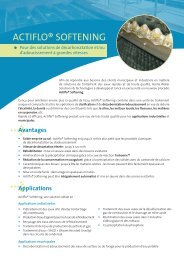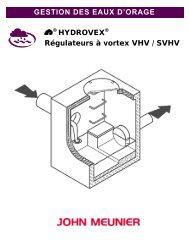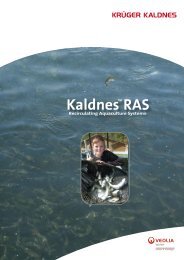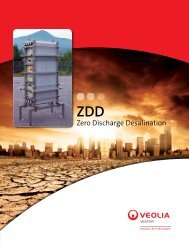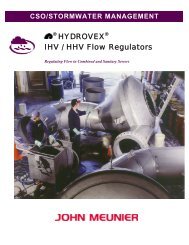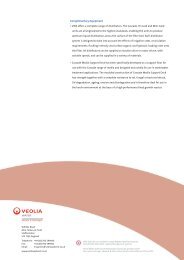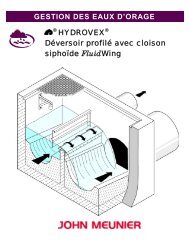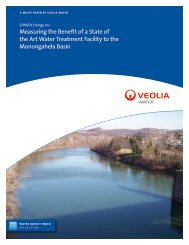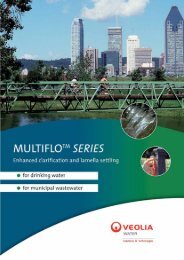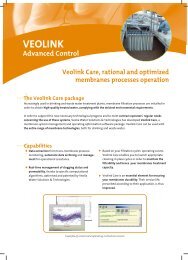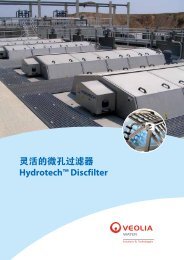IFAT Trade Show 2012 - Veolia Water Ireland
IFAT Trade Show 2012 - Veolia Water Ireland
IFAT Trade Show 2012 - Veolia Water Ireland
Create successful ePaper yourself
Turn your PDF publications into a flip-book with our unique Google optimized e-Paper software.
<strong>Veolia</strong> <strong>Water</strong> News<br />
www.veoliawaterst.com <strong>IFAT</strong> <strong>2012</strong> Edition | Hall A3, Stand 139-238<br />
<strong>IFAT</strong> Newsletter<br />
Summary<br />
New: Memthane ® , for<br />
industrial high-strength<br />
wastewater<br />
Production of bioplastics<br />
from sludge<br />
Zero pollution, 100%<br />
responsibility<br />
Global leader in water<br />
treatment<br />
Soft and uranium-free<br />
drinking water<br />
The power of sludge<br />
Exelys: energy-efficient<br />
thermal hydrolysis<br />
Roche uses energy from<br />
wastewater<br />
<strong>Water</strong> reuse and energy<br />
recovery in France<br />
Reduce CAPEX and OPEX<br />
with new design for<br />
digesters<br />
Treating the Fukushima<br />
contaminated water<br />
Largest hybrid<br />
desalination plant<br />
in the world<br />
Manage water supplies<br />
more efficiently<br />
Zero liquid discharge<br />
at Shell’s GTL complex<br />
in Quatar<br />
Innovative water<br />
treatment on world’s first<br />
floating LNG<br />
<strong>Water</strong> reuse plant in<br />
Australian office building<br />
Emergency mobile<br />
drinking water systems<br />
Three awards to Swedish<br />
wastewater treatment<br />
plant<br />
Reduced carbon<br />
footprint with CARIX ®<br />
Heavy metal removal<br />
without sludge<br />
generation<br />
Dragon Mining improves<br />
efficiency of wastewater<br />
treatment<br />
Cost-effective solution<br />
to treat ammonia<br />
State-of-the-art online<br />
control of wastewater<br />
systems<br />
1<br />
1<br />
1<br />
2<br />
2<br />
2<br />
2<br />
3<br />
3<br />
3<br />
4<br />
4<br />
4<br />
4<br />
5<br />
5<br />
5<br />
6<br />
6<br />
6<br />
7<br />
7<br />
7<br />
New: Memthane ® , for industrial<br />
high-strength wastewater<br />
Memthane®, <strong>Veolia</strong>’s Anaerobic<br />
Membrane Bio-Reactor (AnMBR),<br />
delivers high-energy efficiency and<br />
superb quality effluents, enabling<br />
wastewater treatment system clients<br />
to simultaneously save money<br />
and improve their environmental<br />
performance.<br />
Memthane® opens the door to treating<br />
high strength, high solid wastes<br />
found in industries such as distilleries,<br />
dairies (whey), bio-ethanol<br />
producers and instant coffee plants<br />
which were previously considered<br />
untreatable from an economic<br />
standpoint. Memthane® is not just<br />
an Anaerobic MBR technology, but<br />
a small footprint solution that offers<br />
an array of benefits, eliminating disposal<br />
costs while generating valuable<br />
biogas and remaining easy to operate<br />
and maintain.<br />
Memthane® maximizes<br />
renewable<br />
energy production<br />
while producing<br />
superb quality effluent<br />
that can be<br />
discharged directly<br />
to the sewer or often<br />
easily reused.<br />
The suspended<br />
free effluent can<br />
also facilitate easy recovery of nutrients<br />
for fertilizer production. With a<br />
COD removal efficiency of >98%, this<br />
powerful green energy source offers<br />
the possibility of making production<br />
plants energy self-sufficient,<br />
reducing the dependency on costly<br />
external fossil fuels.<br />
An innovative yet simple process<br />
Memthane® combines two technologies<br />
with proven track records:<br />
Biothane’s anaerobic biological<br />
wastewater treatment and a Pentair’s<br />
X-Flow Ultra Filtration membrane<br />
separation process. Influent<br />
is fed to the anaerobic bioreactor<br />
where the organic components are<br />
converted into energy-rich biogas.<br />
Next, the anaerobic effluent is processed<br />
through the UF membrane<br />
unit, separating the ‘clean’ permeate<br />
from the biomass. The biomass is<br />
returned to<br />
the bioreactor,<br />
while the ultraclean<br />
filtrate is<br />
discharged as<br />
particle-free,<br />
low BOD/COD<br />
effluent, often<br />
at levels low<br />
enough for direct<br />
discharge<br />
to the sewer.<br />
In addition to<br />
its performance<br />
advantages,<br />
Memthane® delivers<br />
significant<br />
total operating<br />
costs reduction<br />
compared<br />
with other technologies, taking<br />
into account all elements, including<br />
membranes, chemicals, sludge<br />
disposal and overall energy savings.<br />
The simple, single, fully automated<br />
reactor system also offers the possibility<br />
of remote control.<br />
www.veoliawaterst.com<br />
Production of bioplastics from sludge<br />
Research has shown that some bacteria<br />
used to purify wastewater in<br />
biological treatment processes feed<br />
off carbon, which they can convert<br />
into biopolymers, similar to those<br />
produced by the chemical industry.<br />
Cella, a technology developed<br />
by <strong>Veolia</strong> <strong>Water</strong> Solutions & Technologies’<br />
subsidiary AnoxKaldnes,<br />
makes it possible to augment the<br />
biopolymer production potential<br />
of these biological treatment processes<br />
by creating the best possible<br />
conditions for selection of the right<br />
bacteria. The PHA-rich biomass<br />
is then harvested and converted<br />
into a valuable material for plastic<br />
and chemical industries used, for<br />
instance, to manufacture biobased<br />
consumer products and chemicals.<br />
The Aquiris North Brussels sanitation<br />
site was chosen for the implementation<br />
of the first prototype testing to<br />
recover organic matter from municipal<br />
wastewater for conversion into<br />
valuable end-products. It provides<br />
for an ideal facility to implement the<br />
biopolymer production trial as well<br />
as establish a development centre<br />
of resource recovery. With a capacity<br />
of an equivalent population of<br />
1,100,000, the plant brings together<br />
“The valuable<br />
methane-rich biogas<br />
produced can cover<br />
a significant part of<br />
the production plant’s<br />
energy and heat<br />
demand, as high as<br />
100% in distilleries,<br />
for example. ”<br />
state-of-the art technologies for both<br />
the wastewater and sludge management.<br />
In Sweden, a similar ”sister” prototype<br />
is in operation for industrial<br />
wastewater treatment as well as a<br />
first biopolymer recovery prototype.<br />
In the fall of 2011, the first biopolymers<br />
were produced by the<br />
prototypes in Belgium and Sweden,<br />
where various components were<br />
fully incorporated into existing facilities<br />
without any modification of<br />
operating processes. Leveraging on<br />
this initial success, the development<br />
teams in Lund, Brussels and Paris are<br />
now working to fine-tune the process<br />
and optimize the raw-product<br />
characteristics to ensure that they<br />
match the requirements of potential<br />
industrial partners and eventual bioplastic<br />
and other biobased carbon<br />
product end-users.<br />
Zero pollution,<br />
100% responsibility<br />
Building a new city-center wastewater<br />
treatment plant to meet the<br />
growing needs of the population,<br />
comply with European standards<br />
and cater for sustainable development<br />
issues was the challenge set to<br />
<strong>Veolia</strong> <strong>Water</strong> by Marquette-lez-Lille,<br />
in northern France. The plant will<br />
generate a low carbon footprint<br />
and produce biogas. It will meet<br />
the requirements of the European<br />
Directive on the good ecological<br />
status of water as early as 2013. It<br />
will be integrated into the landscape<br />
by architects, including a 7 hectare<br />
park and will focus on reducing noise<br />
and odor pollution.<br />
The plant will have the capacity to<br />
treat wastewater from an equivalent<br />
population of 620,000. It will feature<br />
two separate treatment trains,<br />
one for wastewater (2.8 m 3 /s) and<br />
one for stormwater (5.3 m 3 /s). The<br />
stormwater will be treated in the patented<br />
Actiflo® ballasted flocculation<br />
process, while the wastewater will<br />
successively be treated by:<br />
• Multiflo®, a lamellar settler used as<br />
primary treatment for suspended<br />
solids removal<br />
• Hybas, a biological treatment<br />
hybrid technology combining<br />
the best of two well-known technologies:<br />
activated sludge and<br />
AnoxKaldnes MBBR<br />
• Hydrotech Discfilter, used as<br />
tertiary treatment to polish the<br />
effluent<br />
• For sludge treatment, the implementation<br />
of Exelys, a new<br />
thermal hydrolysis process from<br />
<strong>Veolia</strong>, will reduce the quantity<br />
of sludge produced by 20–40%<br />
and increase the production of<br />
biogas by 15–30% compared to<br />
a standard digestion. After being<br />
dried in a BioCon dryer and<br />
stored, half of the sludge will be<br />
used in agriculture and the other<br />
half in a cement works.<br />
As the Marquette-lez-Lille plant is<br />
located in a densely populated urban<br />
area, particular care has also been<br />
taken in dealing with odors. <strong>Veolia</strong><br />
<strong>Water</strong>’s offer includes full control<br />
over odor emissions, their treatment<br />
and monitoring.
page 2<br />
<strong>IFAT</strong> <strong>2012</strong> Edition<br />
Global<br />
Soft, uranium-free drinking water<br />
leader<br />
in water<br />
treatment<br />
“€2.3 billion<br />
revenue in 2011,<br />
10,767 employees<br />
worldwide”<br />
“Ensured compliance<br />
with the revised<br />
German drinking<br />
water regulation in<br />
force since November<br />
2011 with a limit of<br />
10μg/l uranium”<br />
The largest Uranex plant so far<br />
for removing uranium, and one of<br />
the largest Carix plants for partial<br />
desalination, is in operation in the<br />
waterworks in Windesheim, Rhineland<br />
Palatinate, by the Trollmühle<br />
association.<br />
The geologically-related uranium<br />
content of the water is now reduced<br />
with the aid of these two ion<br />
exchange processes, from an average<br />
14 μg/l to less than 0.1 μg/l. In addition,<br />
the overall hardness is reduced<br />
from 22° to 12° and the nitrate content<br />
from 35 mg/l to less than 25<br />
mg/l. About 42,000 people in 14,000<br />
households in the local area are supplied<br />
with 2.1 million cubic metres<br />
of drinking water a year. The plant<br />
was realised by Krüger WABAG, a<br />
subsidiary of <strong>Veolia</strong> <strong>Water</strong> Solutions<br />
& Technologies.<br />
Building work began in August 2010<br />
and the plant was commissioned in<br />
October 2011, after only 14 months’<br />
construction time. The planned building<br />
time and costs were both strictly<br />
adhered to. The moderate increase<br />
in water costs for the households is<br />
offset by the absence of decentral<br />
water softeners and the lower use<br />
of detergents and descalers that<br />
are harmful to the environment. In<br />
addition, the increased demands on<br />
the water quality and public health<br />
care are taken into account. Finally,<br />
compliance with the revised German<br />
drinking water regulation in force<br />
since November 2011 with a limit of<br />
10μg/l uranium is ensured.<br />
www.krueger-wabag.de<br />
Serving municipal and industrial<br />
clients worldwide through a network<br />
of 135 business units, <strong>Veolia</strong> <strong>Water</strong><br />
Solutions & Technologies:<br />
• delivers engineering and turnkey<br />
design & build projects<br />
• provides client-tailored water<br />
treatment solutions and associated<br />
services<br />
Services: what we deliver<br />
We provide customized best-in-class<br />
water treatment service through our<br />
expertise and 250 market-leading<br />
technologies.<br />
Our worldwide network of local business<br />
units and specialized knowledge<br />
produces added-value service solutions<br />
tailored to the unique needs<br />
of each client.<br />
Value: what we create<br />
We’re experts at reusing, recycling<br />
and leveraging value from water for<br />
clients.<br />
We apply a portfolio of cutting-edge<br />
technologies to:<br />
• treat and reuse wastewater<br />
• produce and recover energy<br />
• extract raw materials<br />
• create valuable byproducts<br />
Responsibility: at the heart of everything<br />
we do<br />
We know that our performance<br />
depends on the creativity and commitment<br />
of our more than 10,700<br />
employees. Our teams deliver the<br />
water treatment solutions that improve<br />
quality of life in communities<br />
around the world.<br />
Our sustainable carbon and water<br />
footprint initiatives help clients respond<br />
to stakeholder expectations to<br />
reduce environmental and resource<br />
impacts.<br />
Clients and host communities trust us<br />
to ensure safety and meet the most<br />
stringent performance standards.<br />
<strong>Veolia</strong> <strong>Water</strong> Solutions & Technologies<br />
is a fully-owned subsidiary of <strong>Veolia</strong><br />
<strong>Water</strong>, the global benchmark for<br />
water services.<br />
www.veoliawaterst.com<br />
The power of sludge<br />
Sludge? Beautiful? Check the<br />
dictionary and you’ll find such<br />
unflattering descriptors as, “mire,”<br />
“muck,” “ooze” and “slush.” Search<br />
for synonyms and it only gets worse:<br />
“guck (or gook),” “slime,” “slop” and<br />
“mud.”<br />
But efforts in recent years to improve<br />
the sustainability of the wastewater<br />
treatment plants that produce<br />
sludge is giving rise to a new vocabulary;<br />
words like, “fuel,” “bio-solid,”<br />
“energy,” “green,” “renewable” and,<br />
particularly resonant in these times,<br />
“economical.”<br />
As municipalities and industrial<br />
companies look for new ways to<br />
manage increasing waste volumes<br />
and control the costs from their<br />
wastewater treatment processes,<br />
the image of the once-lowly sludge<br />
is ascending. Increasingly sludge<br />
is being viewed and treated as a<br />
source of valuable by-products and<br />
agriculturally beneficial ingredients,<br />
such as phosphorus extracted from<br />
struvite. For many sites, however, the<br />
real pay-off comes in the capacity to<br />
recover energy. Proven technologies<br />
such as anaerobic digestion, thermal<br />
hydrolysis, co-digestion or thermal<br />
drying are converting sludge/biosolids<br />
into a valuable energy source.<br />
<strong>Veolia</strong> <strong>Water</strong> Solutions & Technologies<br />
has long regarded sludge not as<br />
a waste but as a resource from which<br />
to extract value for the benefit of<br />
customers. <strong>Veolia</strong> applies an array of<br />
technologies to custom-design value<br />
creating solutions for customers<br />
around the world, including:<br />
• In Hilleroed, Denmark, the Exelys<br />
thermal hydrolysis solution,<br />
combined with anaerobic digestion<br />
maximizes biogas and green<br />
energy production, while minimizing<br />
sludge volumes. Thermal<br />
hydrolysis uses heat and pressure<br />
to break down sewage sludge prior<br />
to treatment by anaerobic digestion.<br />
This considerably increases<br />
the biogas yield and reduces the<br />
quantity of sludge for final disposal.<br />
Biogas production is increased<br />
by as much as 40% and sludge<br />
quantities are reduced up to 35%.<br />
Local subsidy premiums for green<br />
energy also make it possible to sell<br />
excess energy for cogeneration.<br />
The Exelys process will also be<br />
installed at Marquette-Lez-Lille<br />
and Versailles, in France.<br />
• Another leading thermal hydrolysis<br />
technology, Biothelys is being<br />
applied to increasingly large<br />
projects, including at the Esholt<br />
Wastewater Treatment Works in<br />
the UK. The biogas generated from<br />
the process will be used to run a<br />
seven megawatt combined heat<br />
and power plant. The digested<br />
sludge that is generated can be applied<br />
as a fertilizer/soil conditioner<br />
for all crops including cereals,<br />
vegetables and salads as well as<br />
for horticultural applications.<br />
• Applying the BioCon® lowtemperature<br />
sludge thermal<br />
drying process allowed the municipality<br />
of Buffalo, Minnesota,<br />
to do much more than simply<br />
reducing the biosolids mass from<br />
its wastewater treatment plant,<br />
by 95%; it also resulted in 70-80%<br />
savings of the plant’s thermal<br />
energy requirements, helping<br />
reduce operating costs by 50%<br />
(compared to disposal of wet<br />
sludge). In addition to generating<br />
inexpensive renewable energy,<br />
the remaining biosolids are ready<br />
for land application. Expressly<br />
designed for drying of dewatered<br />
sludge from municipal and industrial<br />
wastewater treatment plants,<br />
the solution utilizes a dual-belt<br />
low temperature dryer operating<br />
with a temperature range between<br />
80°C - 180°C, reducing the portion<br />
of water content in the material to<br />
less than 10%.<br />
• The Pyrofluid thermal treatment<br />
solution oxidizes organic matter<br />
contained within sewage sludge<br />
in France, Poland and Russia<br />
amongst other countries. The solution<br />
reduces volumes while it can<br />
also generate energy at plants. At<br />
Marne-Aval in France, for example,<br />
steam from two Pyrofluid furnaces<br />
feed an electricity-generating<br />
turbine, contributing to meeting<br />
the plant’s energy needs.<br />
<strong>Veolia</strong>’s sludge/biosolids expertise<br />
doesn’t stop with energy recovery<br />
solutions: “we are constantly looking<br />
for new ways to derive value and<br />
produce materials that are recyclable<br />
or reusable. In Brussels, Belgium, for<br />
example, we inaugurated a worldunique<br />
bio-refinery prototype<br />
capable of recovering the components<br />
from sanitation plants and<br />
vaporizing them into bio-plastics,<br />
usable in certain industries”, explains<br />
Jean-Marc Philipot, Technical Department<br />
Deputy Manager. <strong>Veolia</strong> also<br />
provides advanced control technologies<br />
to optimize the environmental<br />
and energy performance of facilities;<br />
combined with anaerobic digestion,<br />
the result is energy neutral wastewater<br />
treatment plants…today!<br />
www.veoliawaterst.com<br />
Exelys<br />
energyefficient<br />
thermal<br />
hydrolysis<br />
Biosolids are the largest potential<br />
energy source for a wastewater<br />
treatment facility, and therefore<br />
need to be utilized as effectively<br />
and efficiently as possible. Enhanced<br />
anaerobic digestion is now the<br />
performance benchmark for biogas<br />
production, with thermal sludge<br />
hydrolysis being recognized as the<br />
most effective pre-treatment.<br />
However, traditional batch thermal<br />
hydrolysis systems are somewhat<br />
energy and capital cost intensive. A<br />
truly continuous thermal hydrolysis<br />
system, Exelys has been developed<br />
to overcome these shortcomings<br />
while maintaining a high level of<br />
effectiveness.<br />
Exelys is a simple process: dewatered<br />
sludge with a high solids<br />
concentration (± 25%, which can<br />
be obtained from a conventional<br />
dewatering system) is continuously<br />
pumped under pressure into the<br />
reactor tube. Steam is injected into<br />
the sludge, where it condenses and<br />
heats the sludge. The sludge flows<br />
in a plug-like manner through the<br />
reactor tube at a temperature of<br />
165° Celsius and 8 bar pressure<br />
with a retention time of at least 30<br />
minutes. This provides the conditions<br />
required to hydrolyse the<br />
biological sludge and significantly
Hall A3, Stand 139-238 page 3<br />
increase the biogas potential of this<br />
fraction of the solids going to the<br />
anaerobic digesters. At the end of<br />
the reactor tube, the hydrolysate is<br />
cooled down, first through a heat<br />
exchanger (with heat recovery) and<br />
finally by water addition, to reduce<br />
its temperature and solids content so<br />
that it can be added directly to the<br />
anaerobic digestion process.<br />
“The Exelys<br />
thermal hydrolysis<br />
process consumes<br />
considerably less<br />
energy per unit of<br />
solids hydrolysed<br />
compared to<br />
traditional batch<br />
systems, while<br />
achieving at least<br />
the same level of<br />
performance”<br />
Due to the continuous operation,<br />
high solids content of the feed and an<br />
effective control system, the Exelys<br />
thermal hydrolysis process consumes<br />
considerably less energy per unit<br />
of solids hydrolysed compared to<br />
traditional batch systems, while<br />
achieving at least the same level of<br />
performance. Downstream, there<br />
are less solids requiring disposal,<br />
leading to lower costs. Exelys is<br />
a modular system and therefore is<br />
very flexible, yet at the same time<br />
capital and maintenance costs are<br />
reduced. The high temperature and<br />
pressures in the reactor tube also<br />
produce a sludge hydrolysate that<br />
is truly pasteurized.<br />
Through its innovative design and<br />
continuous operational configuration,<br />
Exelys is the most energyefficient<br />
technology available for<br />
thermal sludge hydrolysis. And due<br />
to the unique characteristics of the<br />
hydrolysed sludge product, Exelys<br />
is the ideal solution for significant<br />
increase of the capacity of the existing<br />
digestion systems.<br />
www.veoliawaterst.com/exelys<br />
<strong>Water</strong> reuse and energy<br />
recovery in France<br />
The Petite Californie wastewater<br />
treatment plant, located in Nantes<br />
(Northwest of France) was recently<br />
upgraded to treat 71,000 m 3 /day of<br />
wastewater, equivalent to 180,000<br />
inhabitants. The upgrade and extension<br />
of the plant not only improved<br />
the quality of the treated wastewater<br />
which is mainly discharged to the<br />
Loire River, but also allowed the plant<br />
to meet stringent requirements<br />
for sustainable development with<br />
regards to water reuse and energy<br />
recovery.<br />
The city of Nantes takes a keen interest<br />
in sustainable development and<br />
opted for an overall energy efficiency<br />
approach which includes biogas production<br />
from mesophilic treatemnt<br />
of the sludge in the plant’s digesters.<br />
Flexible solar panels have also<br />
been installed at the plant. In total<br />
this covers one third of the power<br />
consumption at the wastewater<br />
treatment plant, i.e. the energy used<br />
for lighting and heating.<br />
The residual sludge (12,500 T./year)<br />
is recovered for agricultural use after<br />
treatment by digestion, a technology<br />
which reduces volumes by over 30%,<br />
thus minimizing the environmental<br />
impact of transportation.<br />
The upgrade of the wastewater treatment<br />
processes includes <strong>Veolia</strong>’s<br />
patented Multiflo and Biostyr®<br />
processes, selected on the basis of<br />
their high technical performance, as<br />
well as compactness. The treated<br />
wastewater is used on-site for cleaning<br />
activities and could eventually be<br />
suitable for use at the nearby bus<br />
washing station.<br />
Despite having almost doubled its<br />
capacity, the plant’s surface has been<br />
reduced by half and the vacant area<br />
has been converted into gardens.<br />
The architecture of the premises, of<br />
a bioclimatic type, combines mineral<br />
and vegetal elements, with the creation<br />
of gardens inside the building.<br />
Fully covered, the plant is also<br />
characterized by a minimization of<br />
the sounds and olfactory nuisances.<br />
A permanent network of Odowatch<br />
electronic noses, capable of detecting<br />
64,000 volatile olfactory elements,<br />
was installed and enables to mitigate<br />
the inconvenience of the odors.<br />
“The city of Nantes<br />
takes a keen interest<br />
in sustainable development<br />
and opted<br />
for an overall energy<br />
efficiency approach<br />
for its WWTP”<br />
Reduce CAPEX and<br />
OPEX with newly<br />
designed digesters<br />
Sludge is now more and more<br />
considered as a resource rather<br />
than a waste, so focus is big on<br />
sludge treatment and anaerobic<br />
digestion. Anaerobic digestion is<br />
a highly efficient and widely used<br />
method for green energy production<br />
and stabilizing of sludge. Digestion<br />
converts organic solids into biogas,<br />
significantly reducing the requirement<br />
for sludge disposal, while at<br />
the same time improving its final<br />
dewaterability. The biogas produced<br />
can be utilized for heat and power<br />
production, while disposal costs for<br />
the sludge are significantly reduced.<br />
Therefore, anaerobic digestion is efficient<br />
when it comes to reducing<br />
costs and generating income for a<br />
wastewater treatment plant.<br />
In recent years, <strong>Veolia</strong>’s Danish<br />
subsidiary Krüger has developed a<br />
new design for digesters with the<br />
main purpose of reducing CAPEX<br />
and OPEX while improving the<br />
performance of the digester.<br />
Key elements of the new design<br />
include:<br />
• Construction with a flat roof and<br />
no headspace in the top concrete<br />
part of the digester which results<br />
in a significant reduction in CAPEX.<br />
The design simplifies the construction<br />
and reduces the risk of corrosion<br />
of internal digester surface in<br />
acidic gas headspace.<br />
• Integrated gas cooler (Gas Top)<br />
that improves the gas quality, reduces<br />
foam overflow and acts as<br />
a flame arrester.<br />
• Built-in cleaning and maintenance<br />
possibilities, e.g. easy cleaning of<br />
blocked pipes, removal of sand<br />
and grit during operation, safe<br />
servicing of overhead mixer and<br />
no shut-down of the digester. All<br />
these improvements increase the<br />
operational reliability and reduce<br />
OPEX.<br />
The new design is making the<br />
civil construction easier and much<br />
cheaper.<br />
The Gas Top is important to our<br />
commitment to Service, Value and<br />
Responsibility:<br />
Service: Easy maintenance and<br />
foam removal<br />
Value: Very cost-effective system<br />
designed to avoid expensive<br />
maintenance<br />
Responsibility: Very safe workplace<br />
as gas leakages are prevented<br />
www.kruger.dk<br />
Roche uses energy from wastewater<br />
The pharmaceutical company Roche<br />
Diagnostics has built a new anaerobic<br />
plant for the biological pre-treatment<br />
of a partial wastewater flow at the<br />
Penzberg site in Upper Bavaria. The<br />
plant, which produces energy-rich<br />
biogas, supplements an existing<br />
membrane bioreactor system. The<br />
new anaerobic plant was built by<br />
Aquantis, a subsidiary of <strong>Veolia</strong><br />
<strong>Water</strong> Solutions & Technologies.<br />
The new system pre-treats partial<br />
wastewater flows especially rich<br />
in carbon as well as biologically<br />
degradable liquid waste from the<br />
bio-technological production. A 480<br />
m 3 Biobed® EGSB reactor (Expanded<br />
Granular Sludge Bed) is used for the<br />
biological treatment. In the course of<br />
this process energy-rich biogas is produced,<br />
collected and processed. The<br />
gas is used in a combined heat and<br />
power plant to generate both forms<br />
of energy. The amount of electricity<br />
thus gained will cover more than 90<br />
per cent of the energy requirements<br />
of the wastewater treatment plant,<br />
and the thermal energy will be used<br />
to heat water that supplies a newly<br />
constructed local heating pipeline for<br />
replacing high energy steam. Further<br />
savings will be achieved by eliminating<br />
the upstream aerobic high-load<br />
step. The carbon dioxide emissions<br />
will be reduced by about 1,400<br />
metric tons per year, so that Roche<br />
Penzberg will achieve a sustainable<br />
reduction of its carbon footprint.<br />
The Roche Penzberg plant, with a<br />
size of approximately 350,000 m²,<br />
is one of the largest biotech centres<br />
in Europe and one of the leading<br />
biotechnology research, development<br />
and production centres of<br />
the Roche Group. Over 30 years<br />
of experience in biotechnological<br />
production make the Penzberg site<br />
a pioneer in the industrial application<br />
of biotechnology. Today, approximately<br />
4,800 people work on<br />
site. In addition, the Penzberg facility<br />
is the only international centre for<br />
the development and production of<br />
both diagnostics and pharmaceuticals.<br />
Thus the Group’s Personalised<br />
Healthcare strategy is part of daily<br />
business in Penzberg. Test development<br />
for patient stratification and<br />
research support work hand in hand<br />
with the pharmaceutical scientists to<br />
develop products with clear benefit<br />
for patients. The goal is to deliver diagnostics<br />
and medicines to improve<br />
patient’s health and quality of life.<br />
www.vws-aquantis.com<br />
“The amount of<br />
electricity thus<br />
gained will cover<br />
more than 90 per<br />
cent of the energy<br />
requirements of<br />
the wastewater<br />
treatment plant”
page 4<br />
<strong>IFAT</strong> <strong>2012</strong> Edition<br />
Treating highly contaminated waters at Fukushima<br />
Two and a half months: that’s the<br />
record time it took the AREVA and<br />
<strong>Veolia</strong> <strong>Water</strong> teams to design, deliver<br />
and start up a system able to<br />
treat the contaminated water at the<br />
Fukushima nuclear power plant damaged<br />
by the March 2011 tsunami.<br />
The decontaminated water is then<br />
desalinated and reused to cool the<br />
plant’s reactors.<br />
With a capacity of reducing water<br />
radioactivity by a factor of 10,000<br />
and treating up to 50 tons of contaminated<br />
water an hour, the system<br />
has played an essential role in stabilizing<br />
the situation of the nuclear<br />
plant by improving the access of<br />
workers to strategic parts of the site,<br />
and allowing TEPCO (Tokyo Electric<br />
Power Company) to re-circulate the<br />
waters that are used for cooling the<br />
reactors.<br />
At the heart of the solution put<br />
forward by <strong>Veolia</strong> and AREVA was<br />
Actiflo-Rad, a system which combines<br />
<strong>Veolia</strong>’s proven Actiflo® and<br />
Multiflo technologies with AREVA’s<br />
radioactivity adsorption reagent.<br />
AREVA’s decontamination reagent<br />
captures the radiation and the Multiflo<br />
and Actiflo® processes separate<br />
the “activated” reagents from the<br />
water by concentrating them into a<br />
quantity of thickened sludge which<br />
represents less than 1% of the initial<br />
volume of water. The residual sludge<br />
with a high radioactivity concentration<br />
is extracted and fed into a<br />
concrete underground pit while the<br />
water passes through a complete<br />
desalination and evaporation process<br />
made up of three EVALED TC<br />
evaporators. The desalinated water<br />
is reused in the reactor cooling circuit<br />
while the condensate is stored onsite<br />
in metal tanks.<br />
The Actiflo-Rad system can treat<br />
up to 50 m 3 /hour of contaminated<br />
water. It has been a key element<br />
in TEPCO’s system which probably<br />
avoided the release of 40,000 to<br />
50,000 m 3 of contaminated water<br />
into the sea.<br />
Largest hybrid desalination<br />
plant in the world<br />
Fujairah 2 is the largest hybrid desalination<br />
plant in the world, with a<br />
capacity equivalent to 591,000 m 3 /<br />
day of drinking water. The hybrid<br />
desalination plant is exceptional by<br />
its size but also because it combines<br />
the two technologies, Multiple Effect<br />
Distillation (MED) and Reverse<br />
Osmosis (RO), to which is added a<br />
pretreatment Dissolved Air Flotation<br />
(DAF) system. This state-of-the-art<br />
combination has proven to be a solution<br />
which meets the requirement<br />
for a constant, high quality drinking<br />
water output, despite vast seasonal<br />
variations in the power output as<br />
well as algae bloom periods.<br />
Hybrid desalination: the most<br />
energy-efficient solution to produce<br />
desalinated water<br />
The desalination plant is linked to<br />
a 2,000 MW power plant. The high<br />
drinking water demand in UAE does<br />
not vary substantially with the seasons<br />
whereas the power demand<br />
does: during summer, the power<br />
demand is high due to the use of<br />
air-conditioning whilst it is lower during<br />
the winter months. Therefore, an<br />
innovative hybrid solution including<br />
MED and RO was called for to best<br />
match the demands from a cost as<br />
well as a performance perspective.<br />
The hybrid design is the most energyefficient<br />
solution for production of<br />
desalinated water today.<br />
The MED system composes the first<br />
section of the desalination plant<br />
and is the largest system of the<br />
two. It includes 12 MED units that<br />
are driven using steam extracted<br />
from the three condensing steam<br />
turbines and from the exhaust of the<br />
back pressure steam turbine. This<br />
provides maximum output from<br />
the MED units during the summer.<br />
The second part of the desalination<br />
plant is based on RO and is driven by<br />
power rather than steam, therefore<br />
it can be operated independently of<br />
steam output and be used during<br />
winter to maintain water output<br />
when power demand is low.<br />
Spidflow: a new generation of<br />
rapid flotation<br />
Algae bloom periods are often a<br />
problem in the region. Taking this<br />
into account, the technical solution<br />
put into place also features an innovative<br />
pretreatment solution<br />
upstream of the RO system: <strong>Veolia</strong>’s<br />
Spidflow Dissolved Air Flotation<br />
(DAF). Clarification of water containing<br />
low density particles is a delicate<br />
step, especially during episodes of<br />
fast algae bloom. Spidflow specifically<br />
fits seawater desalination<br />
pre-treatment, as an upstream step<br />
of a Reverse Osmosis membrane<br />
treatment chain. It is especially efficient<br />
during red tide periods and<br />
provides unequalled water treatment<br />
efficiency by eliminating over<br />
99% of algae content. The efficiency<br />
was confirmed during a strong algae<br />
bloom in February 2011, when<br />
Fujairah 2 was able to maintain its<br />
daily production capacity while other<br />
plants in the region were forced to<br />
shut down or greatly reduce their<br />
production.<br />
Manage water supplies more efficiently<br />
“The <strong>Water</strong> Impact Index expands on existing<br />
volume-based water measurement tools<br />
by incorporating multiple factors such as<br />
volume, resource stress and water quality. ”<br />
<strong>Veolia</strong> <strong>Water</strong> created the <strong>Water</strong><br />
Impact Index as an innovative and<br />
comprehensive water foot-printing<br />
tool designed to help decisionmakers<br />
achieve sustainable water<br />
management.<br />
Current sophisticated water footprints<br />
focus almost exclusively on<br />
volume – a very good indicator to<br />
raise awareness but not sufficient<br />
to represent the impact on a water<br />
resource. The <strong>Water</strong> Impact Index<br />
expands on existing volume-based<br />
water measurement tools by incorporating<br />
multiple factors such as<br />
volume, resource stress and water<br />
quality. It examines the impact of<br />
human activity on water resources<br />
and provides a methodology for<br />
establishing positive and negative<br />
implications of how water resources<br />
are managed. The new tool provides<br />
additional parameters needed to<br />
make informed choices about effective<br />
water management.<br />
Through the <strong>Water</strong> Impact Index,<br />
decision makers can factor in three<br />
essential elements – quantity of<br />
water used, level of stress upon<br />
water resources, and overall water<br />
quality – and develop a much more<br />
detailed, holistic and inter-related<br />
understanding.<br />
The <strong>Water</strong> Impact Index considers<br />
both direct and indirect influences<br />
of an activity from “cradle to<br />
grave”– whether managing a textile<br />
production facility or a wastewater<br />
treatment facility. It incorporates<br />
the volume and quality of the water<br />
extracted and released back into the<br />
environment and adds the <strong>Water</strong><br />
Stress Index (which accounts for the<br />
level of stress on the resource). This<br />
new index gives us the water impact<br />
– and it includes indirect elements<br />
from the production chain such as<br />
energy, raw materials, chemicals,<br />
and waste generated. Through the<br />
<strong>Water</strong> Impact Index, one can better<br />
evaluate how water users (humans<br />
and ecosystems) could be deprived<br />
of water resources through mismanagement<br />
of water or wastewater<br />
systems.<br />
Tested for the first time in 2010 in<br />
Milwaukee, Wisconsin’s metropolitan<br />
area water cycle (in the United<br />
States), the <strong>Water</strong> Impact Index,<br />
combined with a total carbon footprint<br />
analysis, enabled the identification<br />
of several levers for improving<br />
the system’s performance while<br />
reducing its impact. In 2011, many<br />
more projects were set up, including<br />
the optimization of wastewater<br />
treatment of the L’Oréal factory<br />
at Jiangsu, China where the tool<br />
highlighted the benefits in terms<br />
of carbon and water footprints of<br />
the wastewater treatment plant’s<br />
biological treatment.<br />
Zero liquid discharge at Shell’s<br />
GTL complex in Qatar<br />
Pearl GTL, located in north-east<br />
Qatar, is the world’s largest Gas-To-<br />
Liquid complex with an impressive<br />
size similar to that of 450 football<br />
fields. It includes upstream gas production<br />
facilities and an onshore GTL<br />
plant that produces 140,000 barrels<br />
per day of GTL products and approximately<br />
120,000 barrels per day of<br />
condensate, liquefied petroleum gas<br />
and ethane.<br />
The design-build of the Pearl GTL<br />
complex effluent treatment plant<br />
was conducted by a consortium<br />
formed from a 50/50 joint venture<br />
between <strong>Veolia</strong> <strong>Water</strong> and Saïpem<br />
and a local construction company,<br />
Al Jaber.<br />
Due to the size of the operation<br />
and the water scarcity in the region,<br />
Qatar Petroleum and Shell opted for<br />
a sustainable water management<br />
solution, e.g. zero liquid discharge,<br />
with the water produced in the<br />
transition from gas to liquid being<br />
led to an effluent treatment plant,<br />
where it is treated and reused in<br />
the production process. The effluent<br />
treatment plant has a capacity<br />
to handle 45,000m 3 /day.<br />
<strong>Veolia</strong> <strong>Water</strong> designed and completed<br />
the effluent treatment plant,<br />
supported by patented <strong>Veolia</strong> technologies.<br />
In particular, wastewater<br />
will be treated by ultrafiltration and<br />
reverse osmosis, with the objective<br />
of their complete reuse within the<br />
factory process. Thus, no liquid effluent<br />
will be discharged into the natural<br />
environment. Reverse osmosis<br />
brine treatment will be carried out<br />
by evaporation and crystallization,<br />
a technology achieving zero liquid<br />
discharge where only salt crystals<br />
are produced.
Hall A3, Stand 139-238 page 5<br />
Innovative water treatment<br />
on world’s first floating LNG<br />
The largest floating facility ever built<br />
“The MPPE system has<br />
proven to be the ideal<br />
solution to aim at zero<br />
harmful discharge<br />
by removing toxic,<br />
dissolved and dispersed<br />
hydrocarbons”<br />
Royal Dutch Shell plc (Shell) has<br />
opted for the Macro Porous Polymer<br />
Extraction (MPPE) technology for<br />
the Prelude FLNG-project (Floating<br />
Liquefied Natural Gas) in Australia,<br />
the first floating LNG plant. The<br />
MPPE unit will be used to treat<br />
the produced water of this floating<br />
structure, the largest in the world<br />
(488 meter length, 74 meter wide).<br />
During the production of natural gas,<br />
formation and dehydration, water is<br />
“co-produced”. This produced water<br />
contains dissolved and dispersed<br />
aromatic, aliphatic and polyaromatic<br />
hydrocarbons. <strong>Veolia</strong>’s MPPE water<br />
treatment technology is the only<br />
compact technology that can achieve<br />
Shell’s ambitious environmental<br />
goal to go for zero discharge of environmentally<br />
harmful substances.<br />
The Prelude FLNG project is the first<br />
Australian upstream project with<br />
Shell as operator. Together with<br />
Technip and Samsung, who form the<br />
consortium which was awarded the<br />
construction project, Shell’s ambition<br />
is to develop more FLNG projects<br />
in the world. The FLNG technology<br />
is an important development as it<br />
reduces both the project costs and<br />
environmental footprint of an LNG<br />
development.<br />
<strong>Veolia</strong>’s subsidiary VWS MPP<br />
Systems has extensive worldwide<br />
expertise in the development, marketing<br />
and servicing of separation<br />
systems for wastewater, offshore<br />
produced water, process water and<br />
groundwater streams.<br />
With its robust and flexible operation<br />
and growing range of applications,<br />
the MPPE system has proven to be<br />
the ideal solution to aim at zero<br />
harmful discharge by removing toxic,<br />
dissolved and dispersed hydrocarbons.<br />
www.vwsmppsystems.com<br />
Emergency mobile drinking<br />
water systems<br />
Eight water treatment systems have<br />
been developed for the German<br />
Federal Agency for Technical Relief<br />
(THW) by Berkefeld, a <strong>Veolia</strong> <strong>Water</strong><br />
Solutions & Technologies subsidiary.<br />
The THW water treatment specialist<br />
teams are equipped with the type<br />
TWA 15 UF transportable systems.<br />
The modular, highly-mobile water<br />
systems encompass various stateof-the-art<br />
technologies which can be<br />
combined with each other depending<br />
on the water quality available in<br />
the emergency area.<br />
The plants provide the agency with<br />
a Germany-wide network of water<br />
treatment facilities which also fulfil<br />
the German Drinking <strong>Water</strong> Regulations.<br />
This means that the plants<br />
are approved not only for disaster<br />
relief worldwide but also for emergency<br />
municipal water supply in<br />
Germany. The THW thereby offers<br />
itself as a partner to the German<br />
drinking water suppliers for planned<br />
or unforeseen cases of temporary<br />
emergency supply.<br />
Depending on the combination of<br />
the process steps, a TWA 15 UF<br />
system provides up to 15m 3 /hour of<br />
clean drinking water to supply up to<br />
about 2,400 inhabitants if the water<br />
is fed into the grid, or about 18,000<br />
if it is distributed in canisters.<br />
The plant’s core component is a<br />
highly-effective CeraMem® ceramic<br />
ultrafiltration membrane with a pore<br />
width of 0.1 μm by which viruses<br />
and germs are reliably removed from<br />
the water. The ceramic membrane is<br />
structured as a monolith block and<br />
therefore is especially stable. In addition,<br />
disinfection with ultraviolet<br />
light and chlorination ensures a safe<br />
drinking water quality. Upstream are<br />
a coagulation and adsorption unit<br />
as well as pre-filtration with automatically<br />
back-washable discfilters.<br />
The system also includes a storage<br />
unit for 40m 3 of drinking water and<br />
a distribution and sludge disposal<br />
module.<br />
Due to the modular concept, these<br />
water treatment plants can be<br />
transported to the action site in commercial<br />
aircraft and trucks, erected<br />
without great effort and quickly put<br />
into operation. The predominantly<br />
automatic control and the reduced<br />
need for chemicals ease the efforts<br />
of the aid workers on-site.<br />
www.berkefeld.de<br />
<strong>Water</strong> reuse plant in Australian office building<br />
“Designed with<br />
sustainability<br />
principles in mind, the<br />
Recycled <strong>Water</strong> Plant<br />
helps to reduce the<br />
environmental footprint<br />
of the overall project, as<br />
it eliminates the need to<br />
transport large volumes<br />
of water to and from<br />
centralised wastewater<br />
treatment plants.<br />
Through continued<br />
innovation in design<br />
and operating principles,<br />
it also reduces carbon<br />
footprint compared to<br />
alternative treatment<br />
systems.”<br />
The Darling Quarter development is<br />
a $500 million low rise commercial<br />
office and leisure space in Sydney’s<br />
Darling Harbour. Significant sustainability<br />
initiatives were put in place,<br />
including a reduction in potable<br />
water consumption of 92% through<br />
rainwater harvesting and onsite<br />
wastewater recycling. The project<br />
was awarded a 6-Star Green Star<br />
Office Design rating by the Green<br />
Building Council of Australia.<br />
The Darling Quarter Recycled <strong>Water</strong><br />
Plant combines leading-edge biological<br />
and membrane processes by <strong>Veolia</strong><br />
<strong>Water</strong> Solutions & Technologies,<br />
including the AnoxKaldnes MBBR<br />
(Moving Bed Biofilm Reactor) and<br />
the hollow fibre Ultrafiltration membrane<br />
(UF) to remove very efficiently<br />
bacteria, suspended solids and BOD<br />
/ COD, followed by Reverse Osmosis<br />
to remove salts and particles larger<br />
than 0.0001 µm and Ultraviolet and<br />
Chlorination to kill bacteria, protozoa<br />
and viruses. The plant produces 166<br />
kL/day (60 ML/year) of high quality<br />
treated water which is used for toilet<br />
flushing, garden irrigation and cooling<br />
tower make up.<br />
The treatment plant was designed<br />
by <strong>Veolia</strong> to be a completely closed<br />
plant, with all waste streams<br />
(screenings, sludge and brine) being<br />
combined and sent directly to<br />
the sewer. <strong>Veolia</strong> <strong>Water</strong> Solutions &<br />
Technologies was the first company<br />
to get permission from the local<br />
water utility to discharge screenings<br />
directly back to sewer. As one of<br />
the first inner city treatment plants,<br />
Darling Quarter benefits from an<br />
innovative and efficient odor extraction<br />
and treatment system, designed<br />
by <strong>Veolia</strong> and residential developer<br />
Lend Lease through a collaborative<br />
approach from the early stages of<br />
the project. This has now created a<br />
benchmark for future city treatment<br />
plants.<br />
By using innovative and highly<br />
efficient technologies with small<br />
footprints, <strong>Veolia</strong> was able to deliver<br />
a treatment plant which is approximately<br />
25% smaller than those of<br />
competitors, saving valuable space<br />
for the building owner to use to earn<br />
additional income over the life of<br />
the building.<br />
Long-term onsite trials have been<br />
performed over the past six months<br />
to optimize the plant’s operations<br />
by reducing energy, chemicals and<br />
waste consumption with successful<br />
preliminary results: energy consumption<br />
has already been significantly<br />
reduced.<br />
www.veoliawaterst.com.au
page 6<br />
<strong>IFAT</strong> <strong>2012</strong> Edition<br />
Three awards to Swedish<br />
wastewater treatment plant<br />
A 1999 joint EU-decision limiting effluent<br />
nitrogen from large municipal<br />
wastewater treatment plants to 10<br />
mg/l led to the construction of an<br />
AnoxKaldnes MBBR (Moving Bed<br />
Biological Reactor) for post-denitrification<br />
at the RYA wastewater treatment<br />
plant in Göteborg, Sweden.<br />
Furthermore, in 2006, the county<br />
administrative board decided upon<br />
new discharge limits for phosphorous<br />
with 0.3 mg/l as guide value.<br />
In practice, this meant that biomass<br />
separation from the planned MBBR<br />
plant as well as tertiary filtration of<br />
the secondary effluent were needed.<br />
After extensive pilot testing, these<br />
functions were combined in the<br />
Discfilter plant.<br />
The RYA wastewater treatment plant,<br />
one of the largest in Scandinavia,<br />
serves the equivalent population of<br />
about 650,000. After screening, grit<br />
removal and primary clarification,<br />
water is treated in the activated<br />
sludge plant with possibilities for<br />
pre-denitrification and simultaneous<br />
precipitation. Trickling filters are<br />
used for nitrification and the newly<br />
installed MBBR for nitrogen removal<br />
in a post-denitrification process. <strong>Water</strong><br />
is finally treated in the Discfilter<br />
plant before being released into the<br />
recipient.<br />
The Hydrotech Discfilter was<br />
selected for biomass separation<br />
from the new post-denitrifying<br />
AnoxKaldnes MBBR and for<br />
effluent polishing following the<br />
existing activated sludge system,<br />
with both functions combined in<br />
the same plant. 32 HSF2220-2F<br />
units with a pore opening of 15 µm<br />
were installed, each with a design<br />
flow capacity of 900m 3 /hour.<br />
The focus has been for a sound and<br />
safe work environment. Odor has<br />
been eliminated through separate<br />
ventilation from each filter and noise<br />
reduced to a minimum by specially<br />
designed filter covers. Stable operation<br />
is ensured by a centralised, selfcleaning<br />
backwash system, on-line<br />
control of filtration performance and<br />
an automatized system for acid wash<br />
of the filter panels. During the first<br />
year of operation less than 1 ‰ of<br />
the filter panels were exchanged.<br />
In 2010, the architectural design of<br />
the discfilter building was recognized<br />
with the prestigious Kasper Salin<br />
“With careful process<br />
control and efficient<br />
tertiary filtration, the<br />
new discharge limits<br />
of 0.3 mg/l in effluent<br />
total phosphorous can<br />
be achieved without<br />
post-precipitation.<br />
In practice, this means<br />
that the effluent<br />
Suspended Solids<br />
concentration is<br />
typically maintained<br />
below 5 mg/l.”<br />
prize and in 2011, the innovative<br />
steel construction of the same building<br />
was awarded a prize. Not only the<br />
innovative design but also the function<br />
has been acknowledged: Gryaab<br />
was awarded the yearly prize of the<br />
Swedish <strong>Water</strong> Association plant<br />
upgrade for the improved nutrient<br />
removal following the plant upgrade<br />
with the AnoxKaldnes MBBR and<br />
the Discfilter processes.<br />
www.hydrotech.se<br />
Reduced carbon footprint<br />
with CARIX ®<br />
With the selection of the appropriate<br />
process technologies and the<br />
design of water treatment plants,<br />
the assessment of associated CO 2<br />
-<br />
emissions becomes more and more<br />
important with many investment<br />
decisions worldwide. Krüger WA-<br />
BAG, a subsidiary of <strong>Veolia</strong> <strong>Water</strong><br />
Solutions & Technologies, has therefore<br />
analysed the carbon footprints<br />
of different processes for softening<br />
of drinking water: the CARIX® ionexchange<br />
process, nanofiltration and<br />
reverse osmosis.<br />
The carbon footprint represents<br />
the total of greenhouse gas emissions,<br />
caused directly or indirectly<br />
by a technology. Thanks to the total<br />
carbon footprint assessment, we are<br />
in the position to determine different<br />
solutions for water treatment and<br />
indicate possible savings with the<br />
associated costs.<br />
The assessment<br />
The survey carried out is based on<br />
the values of a CARIX® unit being in<br />
operation with the actual operating<br />
costs and consumptions. This unit<br />
is compared with a nanofiltration<br />
unit and a reverse osmosis unit. A<br />
common index is the CO 2<br />
equivalents<br />
(g CO 2<br />
/m 3 product water) being generated<br />
during the entire lifecycle. For<br />
all three cases, an average lifecycle<br />
of 25 years was taken as a basis. The<br />
basic output of each plant is 244 m 3<br />
of water per hour. The total emissions<br />
are divided into three main<br />
categories:<br />
• Emissions being generated during<br />
the operation of the unit (raw<br />
water supply, electric power<br />
consumption and operating<br />
materials)<br />
• Emissions being generated during<br />
engineering and construction of<br />
the unit<br />
• Emissions being avoided due to<br />
the CO 2<br />
consumption.<br />
The results<br />
With 161g CO 2<br />
-e/m 3 , the CARIX®<br />
unit has the lowest carbon footprint,<br />
which is a result of the comparatively<br />
low electric power consumption and<br />
the reduction of emissions by the<br />
CO 2<br />
being bound in the wastewater.<br />
Compared with the CARIX® unit, the<br />
carbon footprint of the nanofiltration<br />
and reverse osmosis units were<br />
higher by 68% (NF) and 88% (RO).<br />
Key findings from the investigation:<br />
• With all three units, the biggest<br />
share of emissions comes from the<br />
electric power consumption during<br />
plant operation.<br />
• The category raw water supply<br />
during operation registers emissions<br />
connected with the energy<br />
consumption due to generation<br />
of additional raw water.<br />
• The emissions resulting during<br />
plant engineering and construction,<br />
as well as emissions resulting<br />
from the production of the operating<br />
materials, only represent a<br />
small share of the total emissions.<br />
• The “avoided emissions” are the<br />
share of greenhouse gases being<br />
bound through the CARIX® process<br />
and prevented from passing into<br />
the atmosphere.<br />
www.krueger-wabag.de<br />
Heavy metal removal without sludge generation<br />
Granulate<br />
<strong>Water</strong> containing dissolved<br />
heavy metals<br />
Oxidation<br />
Iron (II) or<br />
Manganese (II) ▼<br />
agent<br />
▼ ▼ pH regulation<br />
▼<br />
Clean<br />
water<br />
“Savings in waste<br />
disposal costs<br />
will normally<br />
be sufficient to<br />
finance the capital<br />
and operating<br />
costs for a<br />
MetClean plant”<br />
It has long been recognised that<br />
adsorption processes are capable<br />
of reducing the amount of many<br />
metals in water and wastewater to<br />
a very low level. Krüger’s patented<br />
MetClean technology utilises the<br />
adsorption process in a fluidised bed<br />
reactor to remove a range of metals<br />
from solutions. Krüger’s experience<br />
includes As and the following metals:<br />
Cd, Cr, Hg, Mo, Ni, Se, Zn, Cu, V, Ba<br />
and Sr. Treatment efficiency is as<br />
high as 99% in a one-step process.<br />
By using MetClean, the weight of<br />
the waste product is reduced by up to<br />
20 times. The waste product resulting<br />
from the treatment is a granule<br />
with a dry solids content of 80-90%.<br />
The savings in waste disposal costs<br />
will normally be sufficient to finance<br />
the capital and operating costs for a<br />
MetClean plant. The footprint of<br />
the MetClean process is relatively<br />
small, making it a very cost-effective<br />
solution for several applications:<br />
• Potable water contaminated by<br />
arsenic or nickel.<br />
• Groundwater contamination due<br />
to leaching of metals such as Cr<br />
is easily eliminated by using a<br />
dedicated fluidised bed reactor.<br />
• Industrial wastewater from metal<br />
treatment industries, wood preservation,<br />
tanning etc. containing<br />
the metals already mentioned.<br />
• Flue gas desulphurisation wastewater<br />
from power plants. Met-<br />
Clean is highly suited for this<br />
heavily contaminated wastewater<br />
and offers a substantial reduction<br />
in treatment and waste disposal<br />
costs. In fact, MetClean is capable<br />
of treating a range of metals<br />
to lower ppb levels than can be<br />
achieved in a traditional precipitation<br />
plant. In this application, the<br />
elimination of the sludge problem<br />
is a very obvious advantage.<br />
www.kruger.dk
Hall A3, Stand 139-238 page 7<br />
Dragon Mining improves<br />
efficiency of wastewater<br />
treatment<br />
The Svartliden Gold Mine is located<br />
700 km north of Stockholm in northern<br />
Sweden, and is operated by the<br />
Swedish subsidiary of Australian<br />
Dragon Mining. Ore from the Svartliden<br />
Gold Mine is extracted from an<br />
open-cast mine and treated in a conventional<br />
crushing and processing<br />
plant (CIL) with a capacity of 300,000<br />
tons of ore per year. The wastewater<br />
from the process is collected in<br />
a sand trap. 95% is recycled while<br />
nitrogen, arsenic and copper needs<br />
to be removed from the remainder<br />
before being discharged into a local<br />
stream.<br />
In order to meet the specified<br />
discharge requirements, <strong>Veolia</strong>’s<br />
Swedish subsidiary VA Ingenjörerna<br />
suggested installing the MetClean<br />
treatment plant, the AnoxKaldnes<br />
MBBR process and Hydrotech<br />
Discfilters.<br />
heavy metals, will help Dragon Mining<br />
meet stringent environmental<br />
discharge limits by reducing Arsenic<br />
(As) from the goldmine water down<br />
to 15 ppb, Nickel (Ni) down to 45<br />
ppb and Copper down to 9 ppb.<br />
The AnoxKaldnes MBBR (Moving<br />
Bed Biological Reactor) is used as a<br />
biological treatment for the removal<br />
of nitrogen. And finally, Hydrotech<br />
Discfilters are used for the removal<br />
of suspended solids produced in the<br />
biological treatment.<br />
VA Ingenjörerna’s control program,<br />
VA-Operatör, ensures that daily operations<br />
run smoothly. Due to the<br />
construction of the plant, there are<br />
fewer costs associated with erection<br />
and operation. The construction also<br />
lends support to Dragon Mining’s<br />
desire to improve the efficiency of<br />
the management of wastewater at<br />
Svartliden.<br />
State-of-the-art online control<br />
of wastewater systems<br />
STAR Control® improves and updates<br />
the control of wastewater<br />
treatment plants on the basis of<br />
on-line measurement of ammonia,<br />
nitrate, phosphate, etc. It comprises<br />
advanced on-line control strategies<br />
for biological/chemical treatment<br />
which lead to savings in energy and<br />
chemical consumptions.<br />
Another advantage of STAR Control®<br />
is stabilization and improvement<br />
of effluent quality through better<br />
utilization of the existing plant capacity.<br />
The control tool can also be<br />
an alternative first step to increase<br />
the capacity of wastewater treatment<br />
plants in order to postpone or<br />
eliminate the need for expansions.<br />
STAR Control® optimizes and controls<br />
the plant’s processes while the SCA-<br />
DA system performs the conventional<br />
basic control of the plant operation<br />
such as alarm handling, supervision<br />
of operation of the mechanical plant<br />
parts, maintenance plans, etc. STAR<br />
Control® supplements the SCADA<br />
system, as it computes and transmits<br />
set points to the SCADA system. STAR<br />
Control® only performs the control<br />
through the SCADA system and when<br />
the control basis is in order.<br />
The operation and reporting of SSTAR<br />
Control® are based on Internet technology<br />
and a graphic user interface<br />
is accessed by network browser on<br />
LAN, ADSL or similar networks.<br />
More recently, the STAR Control®<br />
system was expanded with a new<br />
module for real time control of<br />
sewer and wastewater treatment<br />
plant. The system predicts flow<br />
from radar information and simple<br />
sewer models. The flow predictions,<br />
in combination with measurements<br />
of the system, state results in a full<br />
scale control of the sewer system and<br />
wastewater treatment plant.<br />
www.kruger.dk<br />
The MetClean process, an adsorption<br />
process for the removal of<br />
www.vaing.se<br />
Cost-effective solution to treat ammonia<br />
With the raising awareness on<br />
product recovery from wastewater<br />
treatment plants, sludge digestion<br />
for biogas production is now one<br />
of the key processes towards the<br />
energy producing wastewater treatment<br />
plant. However, sludge digestion<br />
typically means that centrates<br />
highly loaded in ammonia but very<br />
poor in carbon source are returned<br />
to the main wastewater treatment<br />
line, usually adding another 15% to<br />
the ammonia load of the plant.<br />
ANITA Mox is a one-step energyefficient<br />
MBBR process treating<br />
these centrates with little aeration<br />
and no need for external carbon<br />
source. The technology is based on<br />
the growth of ammonium oxidising<br />
bacteria and anammox bacteria as<br />
a biofilm on the protected surface<br />
of MBBR (Moving Bed Bio Reactor)<br />
carriers.<br />
Besides the treatment of centrates<br />
from municipal sludge digestion,<br />
with or without sludge hydrolysis,<br />
ANITA Mox is also particularly well<br />
suited for the treatment of other<br />
streams with a very low C/N ratio<br />
such as:<br />
• Leachate<br />
• Industrial wastewater after<br />
anaerobic treatment (Food &<br />
Beverage industry, etc.)<br />
• Industrial wastewater naturally<br />
highly loaded in nitrogen<br />
(Microelectronics industry, etc.)<br />
• Reject water from sludge<br />
treatment platforms<br />
The ANITA Mox process is being<br />
used successfully on centrates from<br />
Sjölunda (Malmö) and Sundets<br />
(Växjö) Wastewater Treatment<br />
Plants in Sweden. Despite the use<br />
of slow-growing anammox bacteria,<br />
the plants were started-up within<br />
3-4 months to reach their maximum<br />
removal capacity of approximately<br />
90% of NH4-N and 75-80% of TN.<br />
www.veoliawaterst.com/anita
page 8<br />
<strong>IFAT</strong> <strong>2012</strong> Edition<br />
Service | Value | Responsibility<br />
<strong>Water</strong> is too<br />
valuable to<br />
be used only<br />
once<br />
<strong>Veolia</strong> technologies<br />
provide more than<br />
3.5 million m 3<br />
of reused<br />
wastewater<br />
every day<br />
www.veoliawaterst.com<br />
World leader in water reuse through<br />
a complete range of innovative<br />
solutions and technologies<br />
• Hydrotech Discfilters<br />
• Actiflo® High-rate Sand Ballasted<br />
Clarifiers<br />
• Filtraflo TGV Rapid advanced<br />
filtration and adsorption<br />
• Biosep membrane systems<br />
• OPUS Optimized<br />
Pretreatment and Unique<br />
Separation process


